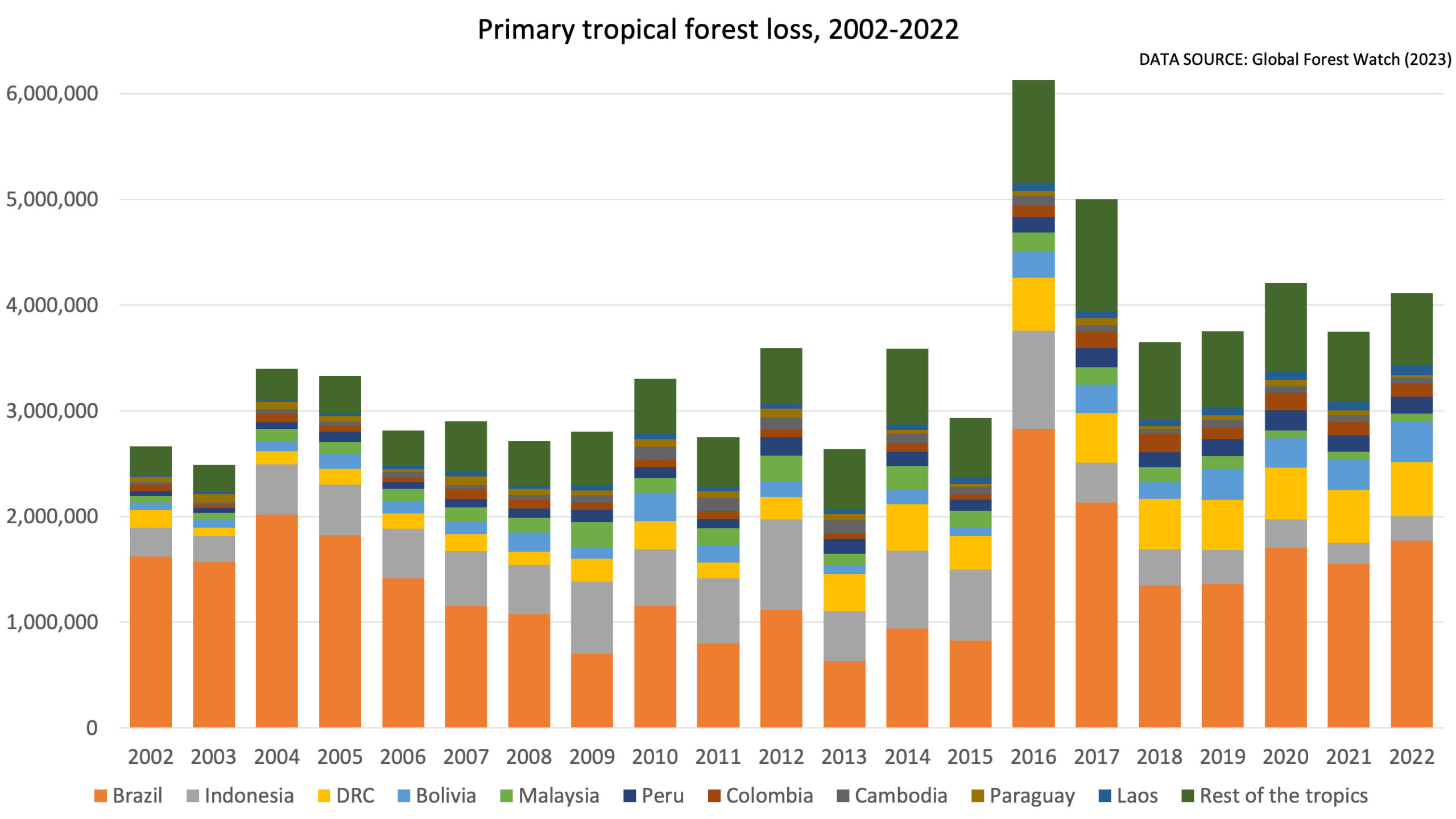- Globally, the tropics lost 4.1 million hectares (10.1 million acres) of primary forest in 2022, 10% more than in 2021.
- These losses occurred despite the pledges of 145 countries at COP26 in 2021 to increase efforts to reduce deforestation and halt it by 2030; the new data, from the University of Maryland, puts the world far off track for meeting the goal of zero deforestation.
- According to Frances Seymour of World Resources Institute, there is an urgent need to increase financing for protecting and restoring forests.
JAKARTA — The tropics lost 10% more primary rainforest in 2022 than in 2021, as forest loss in deforestation hotspots like Brazil and the Democratic Republic of Congo (DRC) continued to accelerate, new data from the University of Maryland show.
According to the data, available on the Global Forest Watch (GFW) platform managed by the World Resources Institute (WRI), the tropics lost 4.1 million hectares (10.1 million acres) of primary forest in 2022, up from 3.75 million ha (9.3 million acres) in 2021.
The forested area lost is the size of Switzerland and the rate of tree cover loss is the equivalent of losing 11 football fields of forest per minute.
“In general, since the turn of the century, we’ve seen a hemorrhaging of some of the world’s most important ecosystems despite years of efforts to turn that trend around,” said Mikaela Weisse, director of GFW.
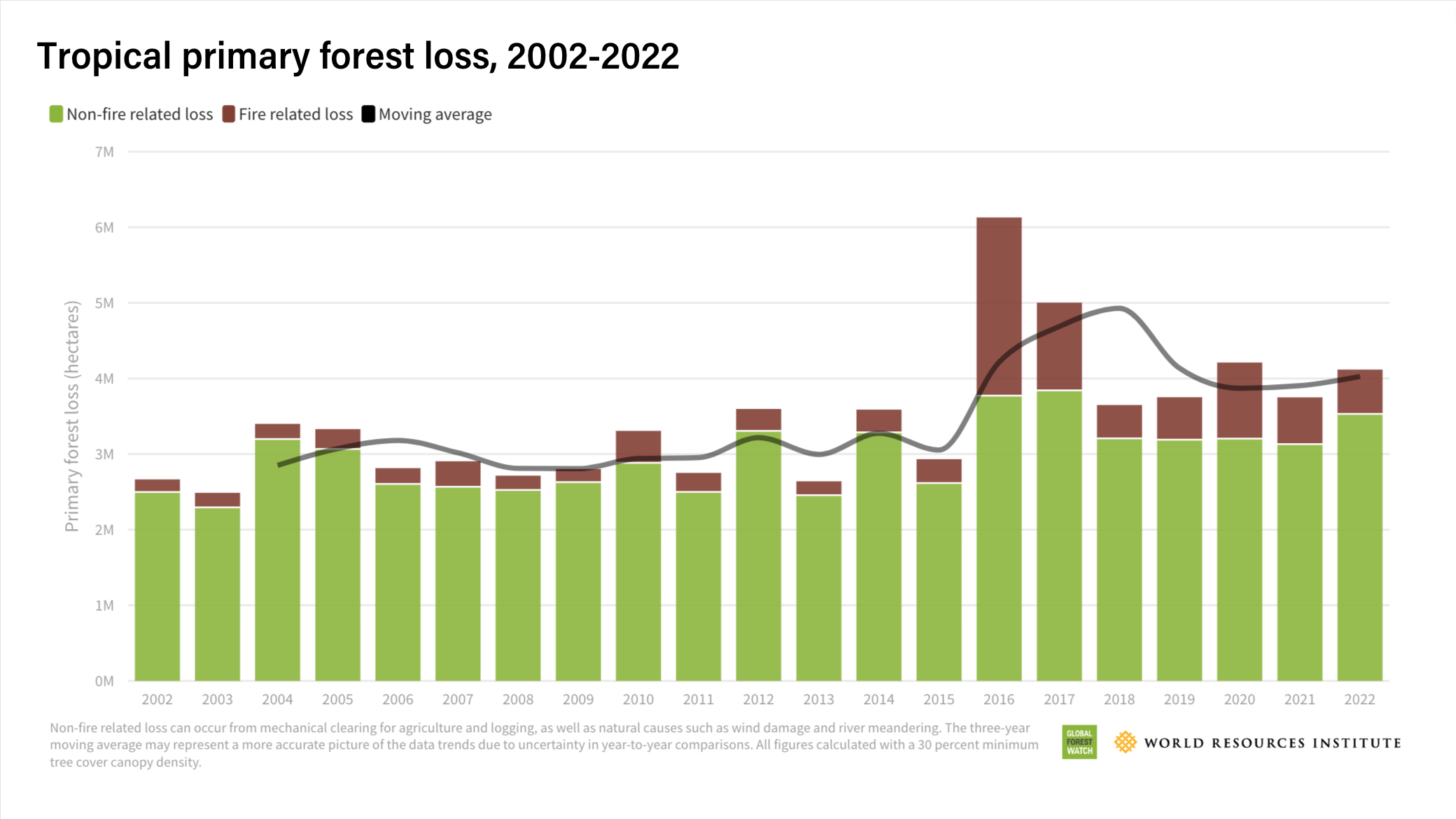
During the COP26 climate summit in Glasgow in 2021, heads of 145 countries pledged to increase the efforts to combat deforestation with a goal to halt and reverse forest loss by the end of the decade.
To achieve zero deforestation by 2030, global deforestation had to be reduced by 10% each year.
But instead, in the first year after the Glasgow pledge, tropical forest loss increased.
As a result, global deforestation in 2022 is more than 1 million ha (2.5 million acres) above the level needed to be on track for the goal of zero deforestation in 2030, according to an analysis by WRI.
This means that we are far off track and trending in the wrong direction when it comes to reducing deforestation, said Frances Seymour, a distinguished senior fellow in WRI’s forests program.
“For many of us, the 2022 numbers are particularly disheartening,” she said. “Following the bold commitments in Glasgow by most of the world’s heads of state to halt and reverse forest loss by 2030, we had hoped by now to see signals in the data that we were turning the corner on forest loss. … We don’t see that signal yet, and in fact, we’re heading in the wrong direction.”
Seymour admitted that it might take some time for the COP26 pledges to result in reduced deforestation.
When governments issue new policies, it takes at least a year to get the administrative capacity in place and making investment, she said.
Therefore, we might see a time lag of a year or two beyond the 2022 data, Seymour said.
“Having said that, I think we shouldn’t be complacent and assume that commitments like the one we heard in Glasgow are self-implementing,” she said.
This is because the money is not there yet to implement these pledges, Seymour said.
She pointed out that the amount of financing from the industrialized world to tackle climate change in general is still insufficient, and the portion of that climate financing going to forest protection and restoration is even lower that the mitigation potential.
Therefore, there’s an urgent need to increase financing to protect and restore forests, Seymour said.
Furthermore, the political will to act on the zero deforestation pledges is also still lacking, she said.
“Collectively we don’t seem to be addressing the problem as the planetary emergency that it truly represents,” Seymour said.
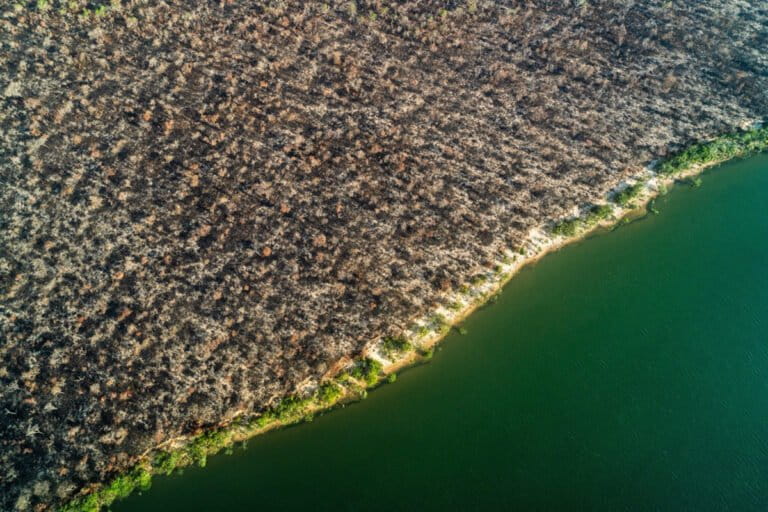
Impact of tropical forest loss
Forest loss in tropical countries in 2022 led to the release of 2.7 gigatons (Gt) of carbon dioxide emissions into the atmosphere, equivalent to India’s annual fossil fuel emissions.
This means that the continued loss of primary tropical forests is pushing the planet’s temperature closer to an increase of 1.5 degrees Celsius (2.7 degrees Fahrenheit) above preindustrial levels.
Therefore, halting and reversing forest loss is urgent and essential to keep the global target of keeping global warming to 1.5 degrees Celsius alive, Seymour said.
“It is also one of the most cost-effective mitigation options available for us today,” she said.
Another reason why it’s crucial to protect tropical forests is because the impact of forest loss, particularly in tropical countries where more than 96% of deforestation occurs, goes well beyond climate change, Seymour said.
For instance, trading wildlife can spread viruses that cause pandemic outbreaks in cities, and irresponsible mining can contaminate rivers downstream, Seymour said.
She said forests also interact with the atmosphere.
“These interactions are usually invisible, but as those of us who live in Washington, D.C. learned just a few weeks ago, smoke from forest fires can cause respiratory distress for populations hundreds of miles downwind,” Seymour said.
Furthermore, deforestation also affects the climate in ways other than through the global carbon cycle, she said.
“That’s through biophysical effects such as the generation of cloud cover and rainfall,” Seymour said. “For example, deforestation in the Amazon region disrupts rainfall patterns downwind and may be linked to the drought and fire … in Bolivia.”
Deforestation is also causing an immediate temperature increase in nearby areas that has the effect of doubling the increased temperature caused by greenhouse warming alone, Seymour said.
This is because forests help to keep air near and far cool and moist due to the way they physically transform energy and water.
Without forests, the global temperature would be around 0.5 degrees Celsius (0.9 degrees Fahrenheit) higher.
“One thing is clear: What happens in the forest, doesn’t stay in the forest,” Seymour said.

Brazil
According to the latest University of Maryland data, the biggest forest losses continue to occur in a few countries that are home to the world’s largest and most significant tropical rainforests for climate change, biodiversity and people.
They include Brazil and the Democratic Republic of the Congo, the two countries with the most tropical forests.
In both countries, primary forest loss continued to tick up.
As the country with the most primary rainforest to begin with, Brazil has consistently topped the list for most primary forest loss.
In 2022, Brazil was responsible for 43% of the total tropical primary forest loss, at 1.8 million ha (4.4 million acres).
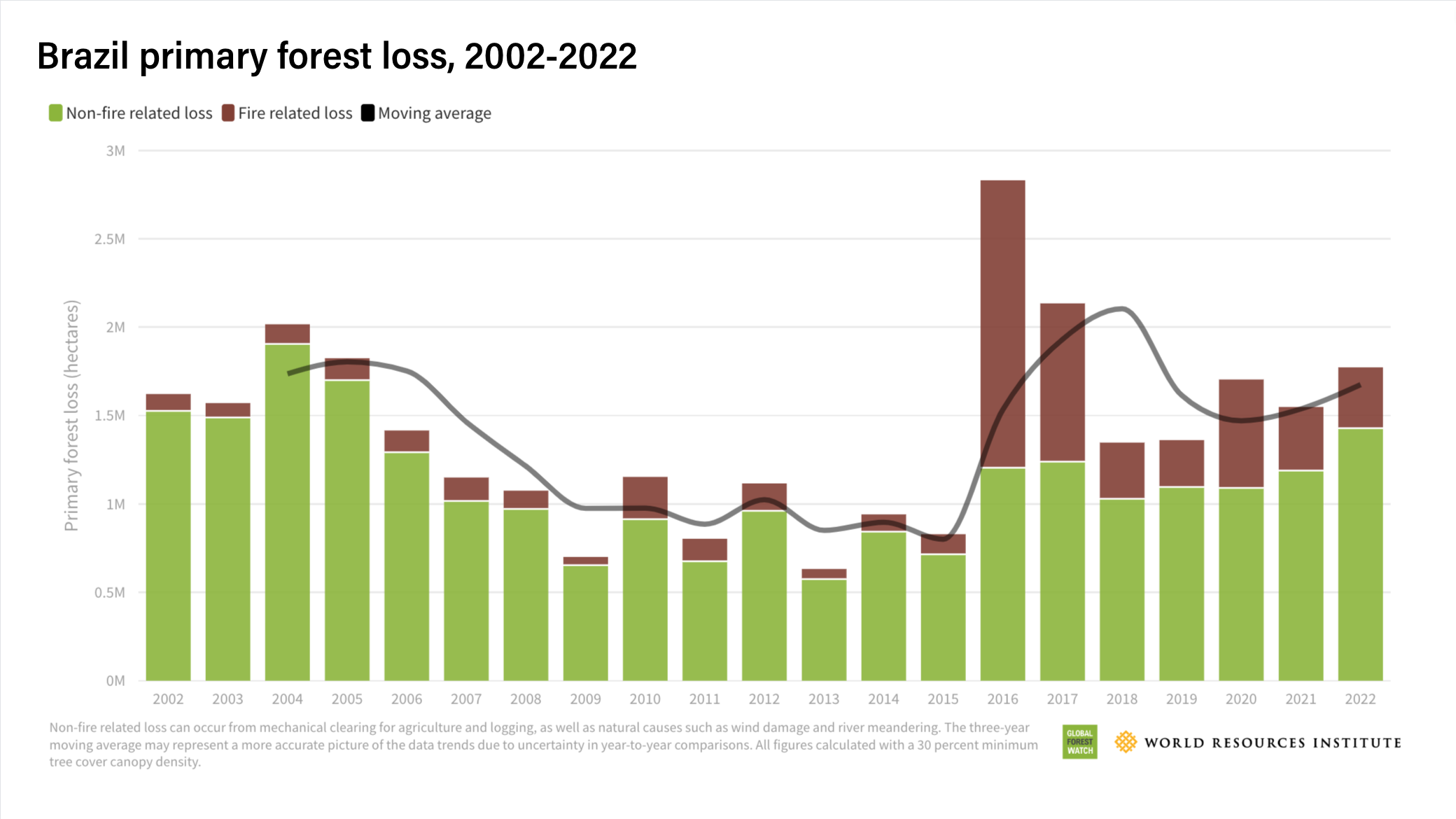
Some of this is due to non-fire-related losses, which in the Brazilian Amazon are most often because of clear-cut deforestation.
Last year, Brazil’s non-fire forest losses increased by 20% from 2021, the highest level since 2005.
Weisse of GFW pointed out that this continued increase of forest loss in Brazil occurred during the last year of former President Jair Bolsonaro’s administration.
“Forest loss in Brazil decreased dramatically in the early 2000s under President Luiz Inácio Lula da Silva (Lula), but recent increases have coincided with the Bolsonaro administration’s eroding of environmental protections, gutting of enforcement agencies, attempted granting of amnesty for illegal deforestation and attempted weakening of Indigenous rights,” she said.
A particular deforestation hotspot that has started to emerge in recent years is the Western Amazon, which has seen accelerating primary forest loss.
The states of Amazonas, home to over half of Brazil’s intact forests, and Acre saw some of their highest levels of primary forest loss on record in 2022.
Amazonas state in particular has nearly doubled its rate of primary forest loss in just three years.

Primary forest losses in the western Amazon is concentrated around existing road networks and mainly consist of large-scale clearings likely for cattle pastures.
Seymour said it’s important to highlight the emergence of deforestation in the western Amazon because the state of Amazonas had historically seen low deforestation despite being rich in forests.
“What we’re seeing in Amazonas is evidence just because forests have been protected in the past, doesn’t mean its condition can’t change quickly and lead to quick increases in deforestation,” she said.
Unfortunately, there’s a lack of financial mechanism to reward high forest, low deforestation (HFLD) jurisdictions like Amazonas for keeping their forests intact instead of cutting them down, according to Seymour.
“And there’s a very active debate internationally right now about how to finance forest protection in these HFLD jurisdictions in a way that incentivizes protecting the forest that we still have standing,” she said. “Because traditional methods of rewarding reduced emissions through deforestation and forest degradation, REDD+, provided rewards against historical baselines of deforestation. And so jurisdictions like Amazonas wouldn’t benefit very much.”
Therefore, there’s a need to double down on providing incentives for jurisdictions like Amazonas to prevent deforestation that hasn’t happened yet, Seymour said.

The DRC
The country with the second-highest rate of tropical primary forest loss is the DRC.
In recent years, the rate of primary forest loss in the country has continued to increase, reaching 0.5 million ha (1.2 million acres) in 2022.

Reducing primary forest loss remains a challenge as poverty in the DRC is widespread and access to electricity is limited, with about 62% of the population living on approximately $2 a day and 81% not having access to electricity.
Therefore, local populations rely on forests for food and energy demand through small-scale agriculture and charcoal production, the dominant form of energy in the region, which is generated by cutting and burning timber.
These have been identified as key drivers of primary forest loss across the Congo Basin.
There are concerns that the DRC’s forests will face greater risks in the future.
Despite committing to uphold the conservation objectives of protected areas, the DRC government recently auctioned off permits for oil and gas exploration in pristine forest and carbon-rich peatlands and indicated that it would soon lift its moratorium on new logging concessions.
As the DRC’s forests continue to be under threat, there’s an urgent need to invest in the country to lift people out of poverty and reduce the reliance on a resource-based economy, said Elizabeth Goldman, GFW senior research manager.

Bolivia
For the third year running, Bolivia had the third-highest primary forest loss in the tropics, falling behind only Brazil and the DRC.
In 2022, Bolivia had its highest year of primary forest loss with a 32% increase from 2021.

Despite having less than half the amount of Indonesia’s primary forest, Bolivia surpassed the Southeast Asian country in its rate of primary forest loss.
Commodity agriculture is the main driver of forest loss in Bolivia.
Weisse said a particular commodity that has been driving deforestation in Bolivia is soybeans, whose expansion has resulted in nearly a million hectares (2.47 million acres) of deforestation in the country since the turn of the century.
Bolivia’s forests might be put under higher pressure in the future as the government supports an increase in agribusiness, with goals to reduce imports, implement biofuel production and increase cattle production.
These goals have been accompanied by the decriminalization of illegal deforestation and an increase in deforestation authorizations.
Fires have also contributed significantly to Bolivia’s forest loss in recent years. In 2022, they were responsible for around a third of total primary forest loss in the country.
“Fires in Bolivia are almost always set by human to prepare land for agricultural activities, but spread out of control due to drought conditions,” Weisse said. “Those droughts themselves might be linked to deforestation, because deforestation in the Amazon disrupts regional precipitation patterns.”
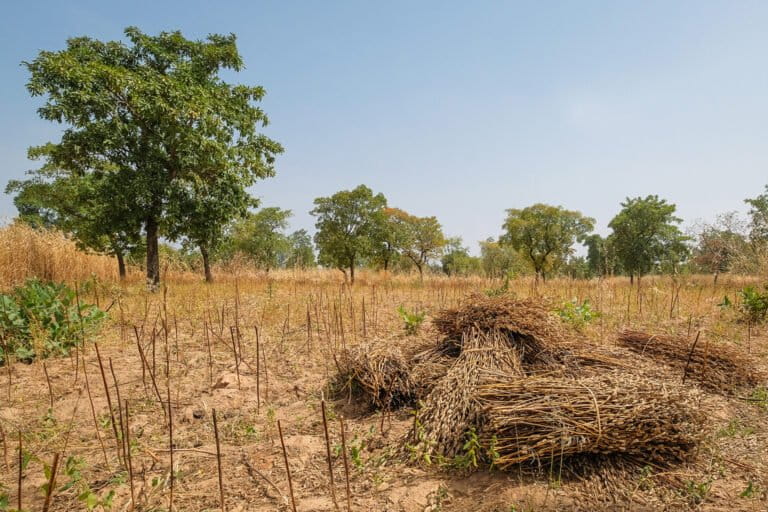
Ghana
Another notable trend from the data is forest loss in Ghana. In 2022, the West African country lost 18,000 ha (44,500 acres) of primary forest, a nearly 70% increase from 2021 and the biggest increase in forest loss of any country in recent years.
This is particularly concerning because Ghana has little primary forest remaining.
But it’s important to notice and recognize that Ghana’s forest loss of 18,000 ha is small compared with the countries with the biggest forest loss, Goldman said.
“This loss in Ghana appears to be encroaching into protected areas, which are the only tracts of primary forest remaining in the country,” she said. “And some of the loss is adjacent to cocoa farms and has a pattern of small-scale clearings that are likely associated with cocoa production, while other patches of loss appear to be linked to fire and gold mining.”

Indonesia
The fourth-highest tropical primary forest loss is in Indonesia. In 2022, the Southeast Asian country, home to the third-largest tropical forest in the world, lost 230,000 ha (568,300 acres) of primary forest.
This represents a slight increase over 2021, when 202,900 ha (501,400 acres) of primary forest were lost.

However, there’s still a continued downward trend in Indonesia’s average rate of primary forest loss.
From 2020-22, Indonesia was able to reduce 64% of its primary forest loss compared with the average from 2015-17.
This means that Indonesia has reduced its primary forest loss more than any other country in recent years, according to Goldman.

She said government policies and corrective actions appeared to be contributing to this reduction.
These policies include increased fire monitoring and law enforcement efforts, a moratorium on new licenses for palm oil and logging plantations that was made permanent in 2019, and renewed commitments to protect and restore peatland and mangrove forest, she said.
Corporate commitment to end deforestation also appears to be working across both Indonesia and Malaysia, where primary forest loss remained low in 2022 and has leveled off in recent years, Goldman said.
She pointed out that 83% of palm oil refining capacity in both countries is now under no deforestation, no peat and no exploitation (NDPE) commitments.
The Roundtable on Sustainable Palm Oil also strengthened certification requirements in 2018 to require no deforestation or peat conversion.
Specific to Malaysia, its government established a palm oil sustainability certification system called Malaysia Sustainable Palm Oil (MSPO).
In 2017, the Malaysian government mandated MSPO certification starting in 2020.
Furthermore, the Malaysian government introduced a plantation area cap in 2019 through 2023. It also enacted new forestry laws in 2022 to stiffen penalties for illegal logging.

Outside the tropics
Globally speaking, tree cover loss, which includes loss of primary, secondary and planted forests, declined by 10% in 2022.
But the decline is more because of a decrease in fire-related losses, particularly in Russia’s boreal forests, which experienced a 34% decrease in tree cover loss between 2021 and 2022.
2022 saw a 28% decrease in fire-related loss from 2021, though some areas still experienced significant fire-related loss, such as in Spain, which had major forest fires and record-breaking tree cover loss.
Meanwhile, globally non-fire losses increased slightly in 2022.
Therefore, the decline in global tree cover loss is not an indication of any positive trend, Weisse said.

Call for action
While some countries, such as Indonesia and Malaysia, have shown promising results to reduce forest loss, others have seen continued activities and policies that are causing acceleration of deforestation in critical areas.
But there are still reasons to be hopeful, Seymour said.
First, there’s a resurgence in the appreciation of the non-carbon benefits of forests, she said.
For instance, the 2022 UN biodiversity conference in Montreal produced a framework that contains a set of goals and targets. These goals and targets are expected to increase financial flows to nature protection and restoration, Seymour said.
Second, new leadership could make a difference, Seymour said.
She cited the example of Brazils President Lula, who took office Jan. 1.
Lula and his administration have promised to end deforestation in the Amazon and other biomes in Brazil by 2030, combining command and control actions with a more long-term perspective around sustainable economic development.
Seymour pointed out that Lula had a track record of dramatically reducing deforestation in the Amazon once before.
At the World Bank, a new president recently took office, Ajay Banga.
He has voiced his commitment to tackle climate change. During his first day on the job, Banga asked the lender’s 16,000 staff members to “double down” on development and climate efforts.
This, Seymour said, could mobilize the considerable resources available to that institution to support countries to integrate forest protection and restoration into their national development plans.
“It’s time to double down on those opportunities because time is running out,” she said.
Banner image: Aerial view of an area in the Amazon deforested for cattle ranching — the biggest driver of deforestation in the Amazon — in Lábrea, Amazonas state on Sep 15, 2021. Photo © Victor Moriyama / Amazônia em Chamas (Amazon in Flames Alliance)
See related:
To meet U.N. climate, biodiversity goals, 79% of plant cover must be saved, study
FEEDBACK: Use this form to send a message to the author of this post. If you want to post a public comment, you can do that at the bottom of the page.


